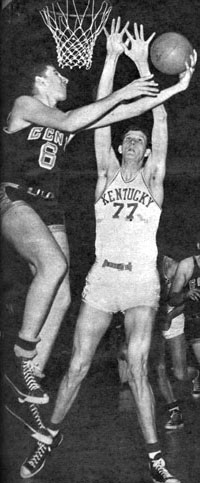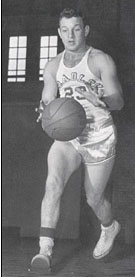The
City College of New York Beavers entered the 1950 National Invitational Tournament hoping to overcome their late season slump. They lost three of their last seven games and eked out their last three wins by no more than four points.
- The NIT at Madison Square Garden in New York was considered the world series of college basketball in the 1940s and early 50s. Winning the NIT, which began in 1938, was considered more prestigious than winning the NCAA tournament, which started in 1939.
- Twelve teams were invited. The top four received byes while the other eight teams played an elimination round.
#11 CCNY met San Francisco in the opening round.
- Apparently not having a good scouting report on their opponent, the Dons were taken by surprise when City came out running.
- CCNY led by 13 at the half, stretched the lead to 22 early in the second half, and coasted to a 65-46 victory.
- Ed Warner, "the tricky Negro sophomore ace of the Beavers," as one 1950 writer put it, scored 26 and joined with Ed Roman in controlling the boards.
That brought City face to face with Kentucky, the defending NCAA champions.
- Adolph Rupp had lost four starters to the NBA from his '48-49 team. But the replacements had developed so fast that the long-time UK mentor was named Coach of the Year.
- But the young Wildcats were no match for the veteran Beavers. City jumped out to a 13-1 lead which grew to 28-9 and reached 45-20 by halftime.
- In one stretch, City ran off 16 straight points in a little over three minutes.
- Roman was assigned the tall task - literally - of guarding Kentucky's 7' C Bill Spivey. Half a foot shorter than his adversary, Ed held Spivey to just three shots in the first half, forced him into four personal fouls, and both outscored and outrebounded his heralded opponent. Ed Warner scored 26 points for the third straight game.
- The result was the worst defeat in 46 years of Kentucky basketball: 89-50.


L: Jim Line (25) and Bill Spivey battle Ed Warner for ball
R:
Shelby Linville can't stop a driving Beaver.


L: Spivey tries to launch a hook shot; R: Ed Roman scores over Spivey.
The
Beavers' inspired play continued into the semifinal with
Duquesne.
- In control from start to finish, City won 62-52.
- Warner was held to 19 but still led all scorers. Roman had 15, Floyd Layne 10, and Irwin Dambrot 10.
- In the other semifinal, #1 Bradley prevented an all-New York final by beating St. John's 83-72.
- That outcome caused the NCAA tournament committee to issue the District Two bid to CCNY rather than St. John's.
City College gave its team a day off from classes on the Friday before the final.
- Coach Nat Holman checked his players into a hotel to eliminate distractions and keep them rested.
- Several players still went to classes they couldn't afford to miss.
26-3 Bradley embodied "a curious mixture of size and maneuverability."
- The Braves' front line consisted of 6'7" Elmer Benke, 6'6" Jim Kelly, and 6'4" Paul Unruh, an All-American F.
- 5'8" Gene Melchiorre led the running game and was the team's second leading scorer behind Unruh. Gene often played the pivot in the half-court offense.
Bradley had won 14 games in a row going into the finals and started like #15 would be easy.
- They led 29-18 after 14 minutes, forcing City to come from behind for the first time in the tournament.
- The Beavers were not playing well - poor shooting from the field and the foul line, erratic passing, and getting beat on the boards.
- When Al Roth blew an easy layup at the end of a 4-on-1 fast break, Holman inserted the more experienced Norm Mager, who had been used sparingly during the season.
- The game turned around immediately as Mager provided much-needed rebounding and defense.
- Bradley failed to sink a FG the last six minutes of the half, and City scored nine straight points to pull within 30-27 at the break.


L-R: Gene Melchiorre; Norm Mager
Both teams came out running the second half.
The NIT champs were hailed at dinners and rallies throughout the Big Apple.
- Mayor William O'Dwyer hosted a rally on the steps of City Hall attended by hundreds of students, faculty, and the college band. "I congratulate you for making the City of New York so proud," he said.
- Back on campus, noon classes were suspended for an impromptu rally attended by 2,000 students.
- Some players were interviewed on radio programs.
- On the third day after the finals, the team rested.
- They would play their first round NCAA game against Ohio State, the nation's #2 ranked team.
Reference: The Game They Played: The True Story of the Point-Shaving Scandal That Destroyed One of College Basketball's Great Teams, Stanley Cohen (2001)